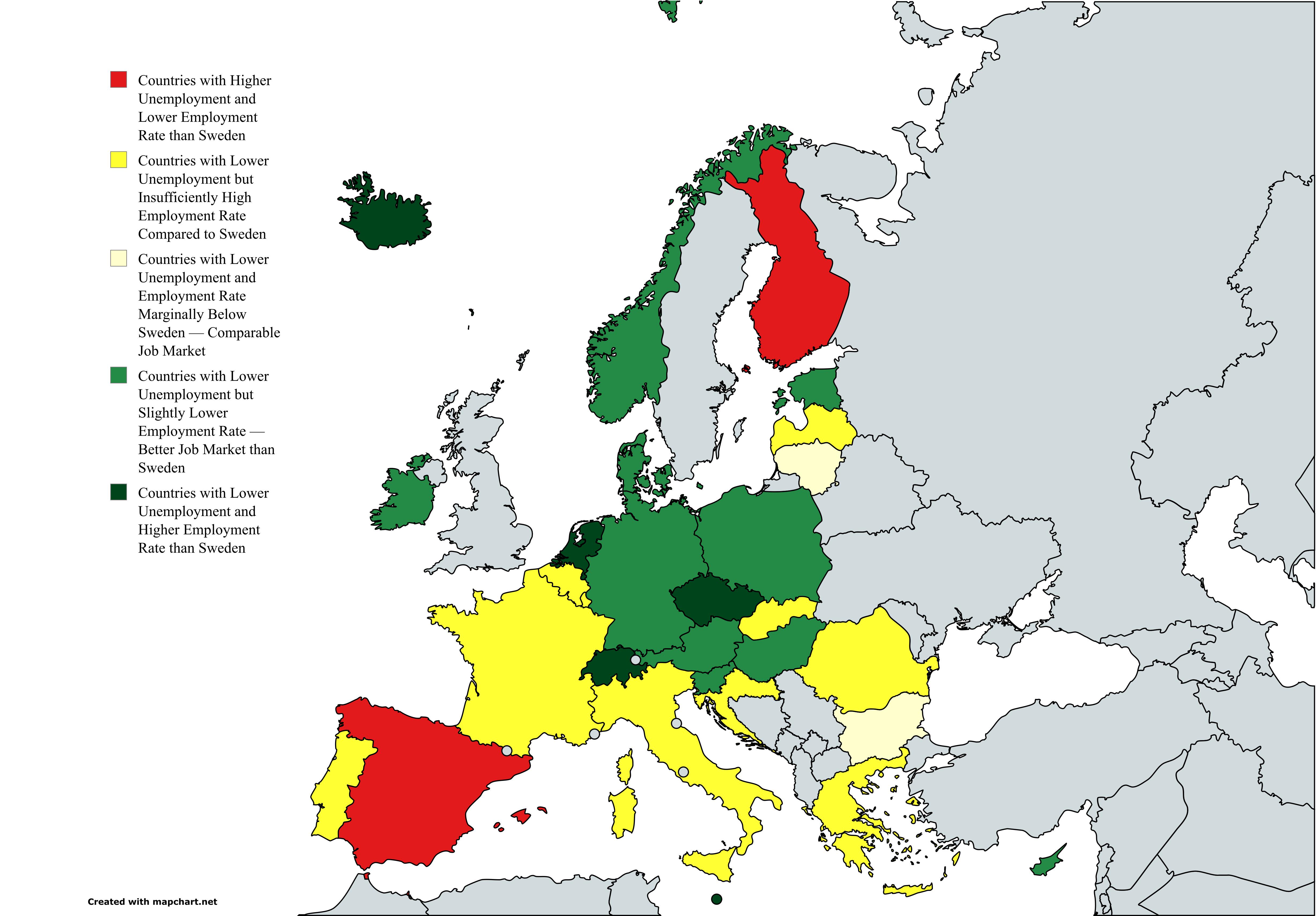Employment and Unemployment Rates Map Relative to Sweden


David Chen
Data Visualization Specialist
David Chen is an expert in transforming complex geographic datasets into compelling visual narratives. He combines his background in computer science ...
Geographic Analysis
What This Map Shows
This map provides a comprehensive visualization of employment and unemployment rates across various European countries, with a specific focus on Sweden as a point of reference. By comparing Sweden's economic indicators with those of its neighbors and other EU member states, we can gain valuable insights into regional labor market dynamics. This analysis is crucial for understanding how employment trends vary across Europe and how they may influence economic policies.
Deep Dive into Employment and Unemployment Rates
Employment and unemployment rates are fundamental indicators of economic health and labor market efficiency. Employment rates, expressed as a percentage of the population that is currently working, reflect the ability of an economy to provide jobs. In contrast, unemployment rates indicate the proportion of the labor force that is actively seeking work but unable to find employment.
Interestingly, Sweden has long been recognized for its high employment rates, driven by a robust welfare state and proactive labor market policies. As of the latest data, Sweden boasts an employment rate of approximately 80%, significantly higher than the EU average of around 74%. This disparity highlights the effectiveness of Sweden’s policies, which emphasize education and skills development, making the workforce adaptable to changing economic conditions.
However, Sweden is not immune to unemployment challenges. The country experiences fluctuations in unemployment rates, often influenced by economic cycles and global events. The unemployment rate in Sweden hovers around 6-7%, which is relatively low compared to many EU nations. For instance, countries like Greece and Spain have faced unemployment rates exceeding 15%, showcasing the stark differences in labor market conditions across the continent.
The reasons behind these differences are multifaceted. For example, countries with higher unemployment rates often face structural issues such as a mismatch between workers' skills and job requirements, rigid labor laws, or economic crises. In Sweden, the government’s active labor market policies, including job training programs and support for unemployed individuals, help to mitigate these issues.
Moreover, various demographic factors also influence employment and unemployment trends. For instance, youth unemployment remains a pressing issue in several European nations, while in Sweden, targeted initiatives have been implemented to integrate young people into the workforce more effectively. This focus on youth employment is crucial as it not only impacts the present labor market but also shapes the future economic landscape.
Regional Analysis
Analyzing the map reveals distinct regional employment patterns across Europe. Northern and Western European countries, including Sweden, Norway, and Germany, generally exhibit higher employment rates compared to Southern and Eastern European nations.
For instance, while Sweden maintains a strong employment rate, neighboring Denmark and Finland also report similar figures, reflecting a regional trend towards robust labor markets in the Nordic countries. In contrast, countries in Southern Europe, such as Italy and Spain, struggle with higher unemployment, often due to economic instability and less flexible labor markets.
The Baltic States, including Estonia and Latvia, showcase rapid improvements in employment rates following economic reforms post-2008, yet still grapple with challenges related to unemployment. Interestingly, Poland has emerged as a success story in the region, with its employment rate steadily increasing, benefiting from a booming economy and a skilled workforce.
Significance and Impact
Understanding employment and unemployment rates is vital not only for policymakers but also for the general public. These indicators can significantly influence economic growth, social stability, and overall quality of life. High employment rates typically correlate with higher consumer spending, increased tax revenues, and improved public services. Conversely, elevated unemployment can lead to social unrest, increased poverty rates, and strained public resources.
As we look to the future, several trends are shaping labor markets across Europe. The rise of remote work, driven by technological advancements and the COVID-19 pandemic, is expected to alter traditional employment landscapes. Additionally, the ongoing emphasis on sustainability and green jobs is likely to create new opportunities, especially in countries like Sweden that are pioneers in environmental initiatives.
In conclusion, the comparison of employment and unemployment rates relative to Sweden not only sheds light on Sweden’s exemplary labor market performance but also highlights the diverse economic realities faced by different regions in Europe. By analyzing these rates, we can better understand the underlying issues affecting the labor market and make more informed decisions that promote economic growth and social cohesion across the continent.
Visualization Details
- Published
- August 10, 2025
- Views
- 142
Comments
Loading comments...